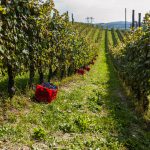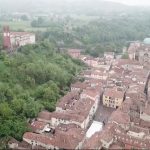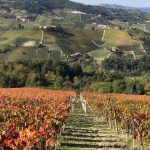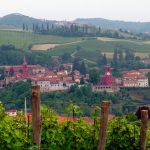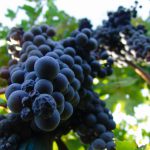Discovering the territory
The Langhe
The Langhe
A land of rolling hills and with noble vineyards that often hide ancient villages and castles.
Rolling hills full of colors with long vineyards of fine grapes.
In Piedmont dialect, the term “Langhe”, is used to describe particular hills with heights between 400 meters, the low langa (bassa langa in italian) and 900 meters above the sea level, the high langa (alta langa in italian).
This particular landscape is characterized by soft and wavy profiles, this is an area mainly located in the Cuneo province, a land that from the city of Alba descends down south to the orographic right of the Tanaro River and up to the northern slopes of the Ligurian Mountains and encroaches, for a short stretch, in the Asti province.
The main element, which almost totally characterizes this historic region of Piedmont, is the roundness shape of its hills. This round, sweet and almost maternal shape that we can find in the fruits of these lands: round grapes and round hazelnuts.
Travelling through these places you can observe the change of seasons, the growing of new leaves or the shedding of leaves in vineyards.
You can see ancient castles on the heights of very scenic landscapes that seem to call each other, touring not to a specific place but making a wide and quiet walk along a network of narrow streets, following the ridges of the hills and the watersheds: this is the meaning of the italian expression “andar per Langa”.
The Langhe are a landscape of great charm, unique in the world, included in June 2014 in the UNESCO World Heritage List. For the first time a vineyard landscape Langhe-Roero and Monferrato has been recognized as having exceptional value and – according to the official reason of inclusion.
“an exceptional example of human interaction with its natural environment”
The two Tanaro banks differ in their geological origins .The hills of the Roero, on the left bank of the Tanaro, are a mosaic of very different soils, with sand and alluvial debris, Roero has an alluvial soil, characterized by sandstone, a rock made of sand and limestone, and it is an area geologically younger.
The right bank, the Langhe, of the more ancient Pliocene, are characterized by a more compact soil, made up of clays and marls, the hills emerged in this ancient phase, about 15 million years ago; have been eroded by the weather over the millennia making these rolling hills and this landscape sweet to the eye.
We are in the Langhe landscape that someone remembers the succession of the calm waves of the sea that here was once.
In Italian we say Langhe, the plural form of Langa, this is because there are several Langhe; bassa and alta Langa, low and upper Langa. The lower Langa is between the Tanaro river in the north and the Belbo river in the south, with altitudes generally less than 600 meters above sea level and the Upper one next to the border with Liguria.
“a happy corner
where time has stood still”
If time is not really stopped, time, in these small villages of the Langhe, has been able to slow down to preserve beauty and traditions of these places in a millennium that goes at “high speed”.
The Langhe have granted themselves the possibility of existing within a world undoubtedly linked to its past, a world in which it is possible to maintain a high level of well-being, not only productive but also existential.
